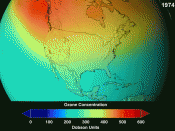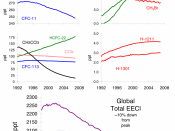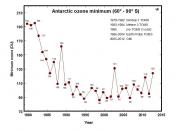In 1985 the Antarctic ozone hole was discovered. The hole in the ozone was discovered by the British Antarctic Survey (Ozone). The Ozone Hole often gets confused in the popular press and by the general public with the problem of global warming. While there is a connection because ozone contributes to the greenhouse effect, the Ozone Hole is a separate issue. However it is another reminder of the effect of man's activities on the environment.
In 1957 British scientists began to measure the Antarctic ozone. Their goal of these observations was to better understand the role that the ozone plays in absorbing solar energy and determining the temperature profile for the stratosphere. Through their investigations the scientists saw that the ozone followed a regular seasonal pattern until 1977 when they started to see differences in the behavior of the ozone layer. Every year after that the ozone became weaker, and by 1984 the ozone was depleting rapidly (Ozone).
The ozone hole is a phenomenon that appears every year in September and October. Through November and December the hole breaks up, and returns to a normal state (Fjaeraa). The serious thinning of the stratospheric ozone layer is caused by anthropogenic emissions of ozone depleting substances, such as chlorofluorocarbons (CFC) and halons. The atmospheric concentrations of these compounds have increased during the last several decades as a consequence of human activity (Ozone).
The Ozone is destroyed in the spring of the Antarctic by chlorine formed during the sunless winter, due to the tilt of the earth. The chlorine is formed by a reaction between stable molecules that are located on small clouds in the stratosphere, which can only form in the intense cold of winter. The stable molecules then obtain the chlorine from CFC's that were broken up by the sunlight during...


